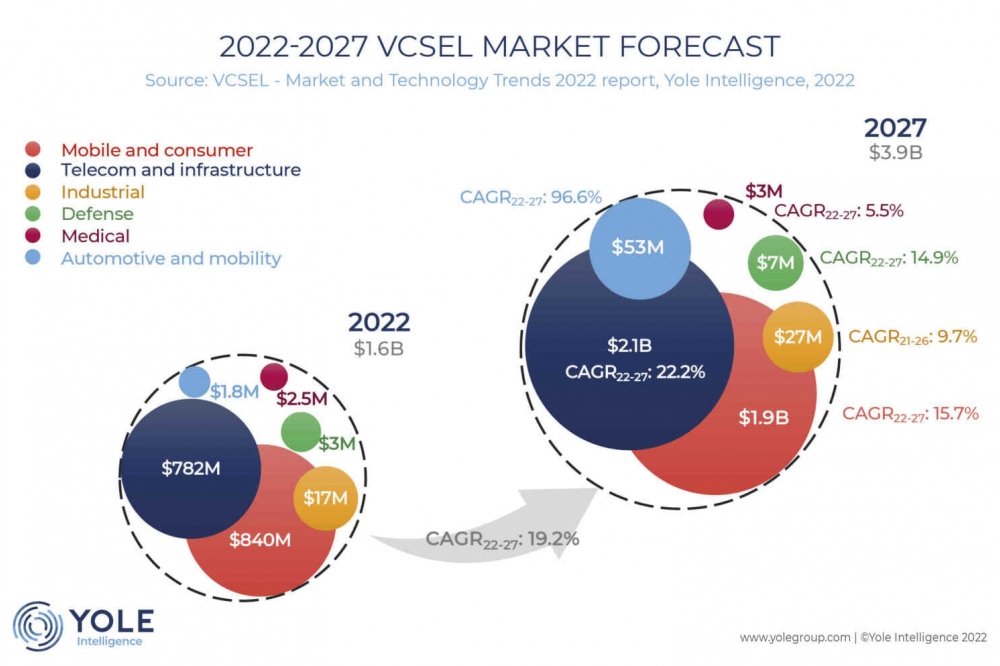VCSEL market shift towards Datacom, says Yole

VCSELs will be a $3.9B market in 2027 driven by consumer and datacom applications
According to Yole's annual 'VCSEL – Market and Technology Trends 2022' report, the VCSEL market in 2022 will reach around $840 million, double what it was 2018.
Traditionally, datacoms was the highest volume VCSEL market. In 2017, Apple changed the game by embedding VCSELs into the iPhone X to allow face recognition, making mobile and consumer apps the largest (reaching $440 million).
Starting in 2023, Yole forecasts that datacom could regain its supremacy and dominate the VCSEL market for the following five years. VCSEL revenues for datacom are expected to reach $2.1 billion in 2027, while VCSEL revenue for mobile and consumer could reach $1.7 billion.
Currently Apple remains almost the only player integrating VCSELs in smartphones. Most other smartphone makers have stopped using these components in favour of under-screen fingerprint sensors.
In 2017, Yole says the VCSEL market was an oligopoly, dominated mainly by Lumentum, though several other players had significant market shares. By 2022, the VCSEL ecosystem had changed and is now a duopoly. Lumentum and II-VI are now the largest players, with 80 percent of the VCSEL market. What has happened in those five years?
Lumentum was the only supplier qualified by Apple at that time. Finisar was still in R&D and struggling to qualify products for Apple. Other players were involved with other smartphone makers or supplying tiny VCSELs for proximity sensors. Then, Coherent (formerly II-VI) acquired Finisar. These two players, Lumentum and II-VI, are still the only players qualified by Apple for 3D sensing.
At the same time, the leaders also acquired other companies, such as Oclaro and Coherent, amongst several others. This reinforced their positions in the optical communication market, vertically integrating from the VCSEL device to the entire transceiver module.
Pierrick Boulay, senior technology and market analyst in the Photonics and Sensing Division at Yole Intelligence said: “Since 2017, VCSELs in smartphones have evolved little. A transition from 4 inch wafer manufacturing to 6 inch wafer was necessary to satisfy the exploding demand from consumer players. This happened between 2016 and 2018”.
Two major changes are expected in the coming years. In May 2022, IQE demonstrated its first 8 inch wafers based on germanium instead of GaAs. These new wafers may not be needed to answer a sudden rise in VCSEL demand but to make possible the integration of photonics devices with CMOS technology. It also gives a potential roadmap toward 12 inch wafer manufacturing in the long term.
The second major change expected is a shift in wavelength from 940 to 1,380nm using dilute nitride active layers. This shift is needed to enable the integration of VCSELs behind OLED displays, which are transparent at this wavelength.
“The iPhone 14 Pro, which was presented in September 2022 embeds a proximity sensor under the display but it could use a laser diode and InGaAs photodetector based on InP substrate waiting dilute nitride technology for VCSELs to be ready,” says Boulay. “As expected, the first long-wavelength application is a proximity sensor under the display, reducing the notch size on iPhones. Further 3D sensing applications could happen later”.



































